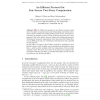109
click to vote
CTRSA
2008
Springer
15 years 2 months ago
2008
Springer
Public key based authentication and key exchange protocols are not usually designed with privacy in mind and thus involve cleartext exchanges of identities and certificates before ...
105
click to vote
CTRSA
2008
Springer
15 years 2 months ago
2008
Springer
Abstract. Camellia and MISTY1 are Feistel block ciphers. In this paper, we observe that, when conducting impossible differential cryptanalysis on Camellia and MISTY1, their round s...
CTRSA
2008
Springer
15 years 2 months ago
2008
Springer
In 2001, Bellare, Namprempre, Pointcheval and Semanko introduced
105
click to vote
CTRSA
2008
Springer
15 years 2 months ago
2008
Springer
We propose and investigate the notion of aggregate message authentication codes (MACs) which have the property that multiple MAC tags, computed by (possibly) different senders on ...
CTRSA
2008
Springer
15 years 2 months ago
2008
Springer
We develop new algorithmic and cryptographic techniques for authenticating the results of queries over databases that are outsourced to an untrusted responder. We depart from previ...
108
click to vote
CTRSA
2008
Springer
15 years 2 months ago
2008
Springer
We present a study of several fault attacks against the block cipher IDEA. Such a study is particularly interesting because of the target cipher's specific property to employ ...
CTRSA
2008
Springer
15 years 2 months ago
2008
Springer
In the 1980s, Yao presented a very efficient constant-round secure two-party computation protocol withstanding semi-honest adversaries, which is based on so-called garbled circuits...
116
click to vote
CTRSA
2008
Springer
15 years 2 months ago
2008
Springer
In the setting of secure multiparty computation, a set of mutually distrustful parties wish to securely compute some joint function of their private inputs. The computation should...
CTRSA
2008
Springer
15 years 2 months ago
2008
Springer
ended abstract appeared in Proceedings of the Cryptographers' Track at the RSA Conference (CT-RSA '08)
CTRSA
2008
Springer
15 years 2 months ago
2008
Springer

